New entrance to Mammoth Cave
By Geo. D. Morrison
A history of the cave together with descriptive guide to routes and illustrations of points of interest.
This immense cavern does not consist of one great room but of a series of marvelous chambers, magnificent avenues and pits and domes. These have been worked out of the limestone by the mechanical and chemical action of the water which threaded its way through the numerous channels, long since abandoned. Throughout the long centuries that have elapsed the solvent action of water has asserted its power and left the monuments of its work that we see in the cave today, as immense pillars, stalagmites, stalactites, helectites, onyx and gypsum formation, crystaline and alabaster flowers.
The vast work accomplished by the water during the centuries may, to some extent, be understood when we consider the magnitude of this Underground Wonderland. It consists of over one hundred avenues, seventy miles of which have been explored; twenty-nine domes, measuring from eight to five hundred feet in height; and sixteen pits, from ten to one hundred and fifty feet in depth. The avenues range from a few feet to eighty-five feet in height and from less than two to over two hundred feet in width. In one instance the width of the main avenue is four hundred and fifty feet and it measures sixty feet in height. It has been computed that over twelve million cubic yards of limestone was removed by the combined action of water in forming this vast cavern. Spring, summer, autumn and winter are unknown in this underground region as an even temperature of fifty-four degrees prevails throughout the year. Not a ray of sunlight has ever penetrated beyond a few hundred yards of an entrance. Oppressive darkness holds sway in these regions of endless gloom. Absolute silence prevades the cavern, broken only occasionally by the sound of water either dripping, flowing, rushing or roaring in its passage on to a lower level.
The country without the cave is well suited for a summer holiday. The scenery is beautiful and picturesque. Virgin forests, charming valleys, fertile fields, and an occasional pond that mirrors the passing clouds — when you add to this the grand ridges with this vast cavern underneath, you have a playground that the equal cannot be found.
And what can equal in wonder and surprise the marvelous halls; the beautiful avenues; magnificent chambers: lofty domes and wonderful grottos, overhung with dazzling splendor, and all shrouded in eternal gloom.
Visit the Cave and all other scenes you have witnessed will be dwarfed in the grandeur. You will be convinced that the .Mammoth Cave of Kentucky stands without a rival, and that the cave region should and will be the Playground of the world.
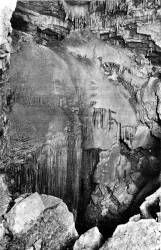
The name, Frozen Niagara, was given to this wonderful onyx formation due to its resemblance to the mighty Falls. This deposit, when examined, is seen to be in curtain-like form, but on approach it has the appearance of an insurmountable barrier, cutting off further travel. Completely filling the avenue from side to side (some fifty feet) and rising perpendicular to within a few feet of the ceiling (a distance of thirty feet) when this beauty comes into view one stands spell bound. It is simply beyond human ability to properly describe it. Men who stated before they entered the cave that their daily business was handling the English language, came out as helpless as those of less accredited ability. A certain editor was very confident that he would be able to express his impression of this formation and upon his return from his visit, when requested to give a description, he struggled seemingly for several seconds for the words that would convey his impressions and then said, "All I can say is that it is simply stupendous, I cannot do justice to it." It is stupendous, marvelous, and any and all adjectives combined fail to give the description desired.
Mammoth Cave has for the century past been known as one of the "SEVEN WONDERS OF THE WORLD." Due to the recent discoveries made and exhibited as the NEW ENTRANCE TO MAMMOTH CAVE, the famous cavern will be able to retain its rightful place as ranking foremost in natural world wonders, although severely challenged by the new discovered Carlsbad Cavern, New Mexico.
The exact date of the discovery of the cave is problematical. "While it is generally conceded that in 1809 the venturesome hunter, Houchins, first entered in pursuit of a wounded bear, there is also a legend, attributed to Bayard Taylor, that it was discovered in 1802. A search of the records at Bowling Green, the county seat, reveal the fact that the Cave was designated as a marker for a corner section of land as early as 1797 and was not only designated as a cave but as a salt peter cave. This would not only imply that the cave was known to the surveyor, but that it had been explored. Sufficient at least to locate the deposits of nitrous or peter dirt. The Indian relics, debris, etc., discovered in the section of the cave now known as chief city, proves that the Indians had access to the underground regions at a prior date. So it is fair to assume that the new purchaser who purchased the cave and dated its history by the manufacture of saltpeter, accepted the legend of the wounded bear. * It is very plausible that the tale of the wounded bear was the means that excited sufficient curiosity to investigation and publicity. At present no data is given in cave history of the owner prior to McLean. Some one must have owned the cave in order to sell to McLean. This man did own the cave. He traded another man a mule for the cave and forty acres of land which he sold to McLean for forty dollars. The old mule was well sold. This former owner was not selling caves or land; he was selling and trading mules. The owner, prior to the mule dealer, was a hunter. He traded Mammoth Cave and land for an old Hint lock. These are the tales of ownership as told in the cave region and relate to squatter titles. So, as far as historical value is concerned, the hunter Houchin and McLean titles may be accepted as the starting point in the history of Mammoth Cave.
McLean soon sold the cave and land to Mr. Gatewood. who resold in 1811 to Messrs. Gratz and Wilkins. They made a fortune from it during the war of 1812. These men brought capital and experience to aid in the manufacture of the then much needed salt peter and although the methods employed were the most primitive, the yield from the cave largly furnished the supply that, despite the general embargo, gave America the victory over Great Britain. The following extract from -World’s Work" gives a summary of the history of that period:
"In 1810, Gratz and Wilkins sold the property to a Philadelphia merchant, Mr. James Moore, who, it is averred, entangled the cave’s fortunes with one of the most romantic lost causes in American history, the attempt of genial, brilliant, adventurous Aaron Burr to carve out a kingdom for himself and his friends in the unexplored West.
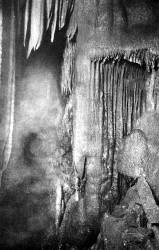
Passing under the falls one enters Old Tutt’s Tomb, a dome-shaped room. Looking up and Looking down one finds oneself at the edge of a pit, twenty feet deep and an equal distance across. The walls of the pit are not perpendicular but stand at a severe slope. With care one can descend to the bottom of the pit, then standing in a huge egg shaped dome, fifty feet in height and thirty feet in diameter. Within this dome where ever the eye may rest one will find beautiful onyx formation from the most fragile and delicate to the huge stalagmites and stalactites taking form as Totem Poles, Pyramids, Markers and in other myraids of shapes. One small onyx stalagmite growing from the floor twenty inches in height and four inches in diameter is noted for its perfect symmetry, sparkling whiteness and polished appearance. Another massive stalagmite calls for special mention as it resembles the trunk of an old tree that has passed to decay and the top has been removed by wind or man.
After the catastrophe of Blenerhassett, Moore was ruined. The estate was purchased by Mr. Prank Gorin in 1837 and the era of discoveries began. The immediate cause of explorations was an accident. Mr. Gorin’s nephew was lost in the cave for thirty-nine hours and it was while searching for hint that many of the wonders in the subterranean vaults were seen for the first time. The fame of the cave began to spread both in America and Europe, but, like most of the world’s great marvels, was least well known at home. John Crogan, a young physician of Louisville, traveling in Europe, heard so much about the marvels of Mammoth Cave and was so mortified to confess his own ignorance about it, that he returned home and bought the property from Mr. Gorin. He expended large sums on its development and at his death in 1845 he bequeathed it to his eleven nephews and nieces.
Its history has been a torchlight procession of admiring tourists" 1 until in 1907, Eignbigler, of New York City, paid a visit to the Cave and became enthused with admiration and it was due to his activities that the vast dome bearing his name was discovered; also a second dome which he named for his sister Edna. While he and his party were enjoying a noon-day lunch a colored lunch carrier, Ed Hawkins, ventured across a dangerous pit which had deterred others of the party, and was rewarded by discovering the passage way which now bears his name, "Hawkins Way" and also "Hawkins Springs."
This passage wav when investigated leads into the "Five Monarchs" known as Cathedral Dome, and described in this book by Hovey and Robertson. This discovery added vast new regions to the then known route of Mammoth Cave.
In 1908 Max Kemper, a German, visited the Cave with the avowed purpose of spending a short period only, but his investigations extended over months and months. Due to his activities Violet City was added to the vast domain; as was also the route extending southeast from the passage way to Cathedral Dome, known as the New Discovery Route. This leads to Saratoga Springs, Forks of the Cave, Alice’s Grotto, the Mammoth Gypsum Wall, the Black Onyx Region and the Crystal Room. This series of discoveries added as much mileage as was formerly known as the Mammoth Cave routes. The Majestic Avenue, known as the New Discovery, equals in size any known avenue in the underground world of wonder.
In the spring of 1916, George D. Morrison, first visited the cave and was so impressed with what he saw that he prolonged his visit until he had thoroughly explored each of the routes open to visitors and was more familiar with the long routes of the cave than were several of the guides whose specialty was the short trips. Having become a cave fan and explored all open routes; having asked innumerable questions of the guides: having read all books issued relative to Mammoth Cave; having secured and studied all available maps of the underground routes; he was convinced that the vast avenues that required six hours steady traveling to reach the point where the guide requested you to return (and the avenue continued on with more signs of increasing than of diminishing) extended miles beyond the present boundaries of the Groghans heir’s estate.
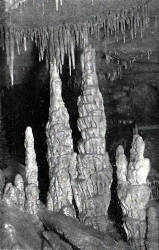
As glimpsed in the picture this region abounds in unnumbered Stalagmites and Stalectites, ranging in size from the size of a quill to massive pillars, in one instance to a single pillar twenty-two feet in diameter.
In following out his investigations he ascertained that in walking in a southeast direction from the cave entrance, he could reach the eastern boundary of the cave estate in fifteen minutes, and in walking south the southern boundary line was reached in thirty-two minutes. Comparing the time required to traverse the cave avenue to turning point, or six hours, to the time required to walk to the estate boundary, or thirty minutes, corrobrated his former conviction that only a parcel of Mammoth Cave was under the land owned by the estate. Being conversant with the laws relative to mineral or subsurface rights, he was not mislead by any false claims that the cave and cavern rights underlying the adjoining tracts of land by any imaginary right or law could belong to the Mammoth Cave estate except by purchase or with the consent of the land owner.
Now having become positively convinced that the cave avenues did extend miles beyond the boundary of land owned by the Croghan Heirs, and that a new entrance could be effected and that this new entrance would open up untold beauty which was accessible from Old Entrance to only those who had the hardihood and endurance necessary to endure eleven to twelve hours of continuous walking.
These regions of beauty which are unsurpassed were so remote from the Old Entrance that in 1916 only one guide of the six claiming to be guides would venture to show the then known New Discovery route. The real guide was Ed. Bishop. He instructed Hunt how to reach the New Discovery from the Cathedral Dome route and Hunt instructed Bob Lively, but during 1916 and 1917 it was necessary to wait for Bishop, to make the trip.
Even at the present time it is doubtful if there is any of the present guides, except. Lively, that can guide a party to the New Discovery or to what was known as Alice’s Grotto. This proves that the efforts to make the New Entrance was based on the fact that a New Entrance was warranted as it would render these regions easily accessible to visitors and would avoid the necessity of retracing of one’s steps for six long hours. No labor is more futile than that of retracing after energy is exhausted in going forward.
It would open up new routes of untold beauty that have been sealed in these remote regions for long ages, antedating the building of the Tower of Babel or the Egyptian Pyramids.
It would make it possible to visit these regions every day of the year while from the Old Entrance these regions are only accessible during the seasons that Green River is within its banks. Any rise in Green River closes the passage of what, is known as Echo River so access from the Old Entrance depended on the rise and fall of Green River. During exploring trips Ganter Avenue was traveled and one must be a true cave fan to take that trip more than once or ever advise a friend to take it. It is simply impossible; more suited to goats than to human beings.
Having become satisfied as to the feasibility, practicability and desirability of a New Entrance, the necessary steps weri’ taken to accomplish the desired results, leases and options were secured on all the tracts of land that touched the cave estate on the Last, South and West, an aggregate of six thousand acres. After securing the needed acreage the question then was to locate the Cave avenues and as there is only one main cave avenue which is about as wide as the average country road and as crooked, and as it passed somewhere across the six thousand acres and was buried some two hundred to three hundred feet below the surface, this was the question that had deterred many and had caused the defeat of all those who had ventured to effect a new entrance.
The many traces of former excavations seen on the hillsides in the cave regions are monuments to such men as Ha/en and Proctor, who spent years and all their means in a futile attempt to locate the cave avenue and effect the New Entrance.

On the wall, some thirty feet up, is a deposit of pure white, fleecy appearing onyx. This has been named "GIDEON’S FLEECE," due to the remarkable resemblance to a white fleecy rug. On the opposite side the wall of the dome recedes, forming a recess. Standing on the opposite side and looking into this recess one gets the impression of a distant view of a vast valley, partially covered with snow flakes, drained by one main stream and several tributaries, with a contour rough and rolling and sides of valley covered with timber. This is due to the channel cut in the lime stone and covered with different shades of onyx. The pure white represents the snow scene.
The top of this magnificent dome is hung with the most marvelous drapery ever formed by nature. No architect or designer could equal the harmony, symmetry, mystery, and variety shown in the innumerable seemingly seperate sheets of formation that make up this crowning drapery. Suspended from the top of this dome and completely covering or filling the top so that no support is visible except the side walls of the dome, the conclusion is readied that this formation is attached and hangs from the roof.
In the question of locating the cave avenue practical knowledge of oil well drilling rendered this a simple question and was solved by moving the drilling equipment to the cave region and drilling a series of holes. The sixth hole drilled located the main avenue within a few feet, the seventh hole drilled located the main cave avenue positively between Holes (> and 7. These two holes were only 160 feet apart. The cave avenue was closer to hole No. 7 than to hole No. (), and the avenue being twenty feet in width at this point, to all needed requirements, the cave was as positively located as though the drill bit had centered the cave.
With the Cave avenue located then came the question of making the entrance. Several methods were considered and this was the deciding factor as to the method pursued: The writer called at one of the country homes and in the conversation the mother told of the children, when young, playing down a deep ravine. The reason assigned for their desire to play in this ravine was that a strong current of cool air issued out from under the rocks on the hot days in summer. The mother stated that in the years since (some 20 years) the washing of the hillside had covered the roeks and closed the air vent. Investigation proved that this reported air vent was according to cave location within six hundred feet of the main avenue of the cave, and the surface location tallied with a strong air current that had attracted attenion when the cave was being explored.
With the checking up of all data at hand this place, described by the country mother, was selected and excavation commenced. Only a few feet had been excavated when an air current was noticahle; this increased as work progressed until a satisfactory air current was reached. Work was continued following this air current through its meanderings. Sometimes the crevice was extremely small — not of sufficient size to admit one hand. Working a passage through the practically solid limestone, following the small air vent, the crevice suddenly burst forth into a huge room or dome. Several of these huge spaces were encountered and as each one was reached hope soared high. It was positively thought, until the room or dome was thoroughly explored, that the mammoth cavern had been reached, but not finding the cave avenue, drilling went on. then the re-discovery of the air current was necessary and sometimes proved very elusive. Men spent days in deciding which was the right crevice to follow and after sixty days of hard laborous work, success crowned their efforts. They reported that, they had broke through into a large dome and with the use of ropes lowered one man to the bottom of the dome. He reported that there were footprints in the dome and it was positive that the party who made the footprints had entered the dome from the mam cave. Further investigation proved that the man who entered the dome was Ed. Bishop, as his name was soon found scratched on the wall and, following his tracks, we were lead to the same opening, where the strong air current was noticed when exploring the underground wonder.
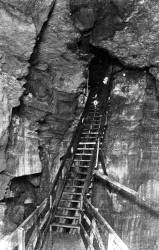
Having effected the much coveted entrance some two weeks was devoted to the surveying and mapping of the underground routes that comprised Mammoth Cave. The surveying and mapping completed, we were ready to announce to the world the New Entrance to Mammoth Cave. In order to properly signify the event, four of the employees of the Old Entrance, who were met in the cave, were invited to come out of the New Entrance, which they did, they being the first persons known to have went in at the Old Entrance and to come out some two miles away and to come hack over the surface. This done, the Collossal Cavern Company was notified that the New Entrance was affected. This New Entrance was made on the W. P. Cox tract of land, the underground rights of which were owned by The Collossal Cavern Co.
The Colossal Cavern Company was notified and their co-operation solicited, but this did not meet with their approval and they immediately enjoined us from any further activities on the Cox tract of land. This seemingly brought to a close any further thought as to a New Entrance to Mammoth Cave, as the Colossal Cavern Company refused to co-operate, and the land owners, namely, W. V. Houchin and the Doyle sisters refused to consider any sale of their tracts of land.
Thus were all activities in the Cave region stopped until in the spring of 1921 when I returned to the cave region with the intention of doing some further explorations there. I thru learned that I could purchase the cave and cavern rights underlying the W. V. Houchin tract and the Velma Cox tract. Under these tracts surveys made in 1916 showed the Cathedral Domes to be located. I was also able to purchase the cave and cavern rights underlying the E. J. & S. F. Doyle tract of land, under which the former survey showed the New Discovery Route of Mammoth Cave. With the cave and cavern rights purchased under these two tracts of land it then became a question of locating the New Entrance on land upon which we held title.
Active work was commenced in May, 1921, and continued at various places until August, 1921, but with no marked degree of success: however, at this time we had under exploration on the Doyle tract of land reached forty feet of the Cave Avenue in depth and 128 feet south of the Cave Avenue. Then came the question of whether to drive this tunnel through the 128 feet or to still seek a new location. With this thought in mind and accompanied by my nephew, Earl Morrison, we started scouting the hillside. On this trip we came into what is known as the Doyle Big Break. This is a vast depression eightyfive feet in depth and 300 feet across the top. The mass of rock which was displaced to cause this depression would equal the mass of rock which forms what is known as the Big Break where the survey stopped in Mammoth Cave in 191(5. I had not visited this section since 1915, and on this visit I recognized that this must he the Big Break which seemed to close the main Cave Avenue. I remarked to Earl that we would secure instruments and run the Cave line that afternoon, which proved that the underground survey of Mammoth Cave stopped within 200 feet of this immense depression.
We at once commenced exploration work in the base of this break. Our first effort being toward the north led us into an underground region showing minor pits and domes and leading 200 feet around the north side of the break. Then we centered our activities to the southwest, and after excavating to a depth of 14 feet a strong air current was discovered. By using twenty sticks of dynamite this opening was enlarged sufficiently to permit men to crawl through. In working out this crawl-way the smallest men in the exploration crew were used; namely, Jack and Lacey, in charge of Earl Morrison.
Jack, making the first passage, a distance of some forty-five feet, with difficulty, entered a large room now designated as the "President’s Office," and in his exploring work accidentally extinguished his light, leaving him in an unknown region in absolute darkness. Lacey was called to go to the rescue of his buddy. On his rescue mission it was noticed that he experienced no difficult v in passing through the crevice. With the additional light it showed that they had entered a room some 40 feet in height and 20 feet in diameter.
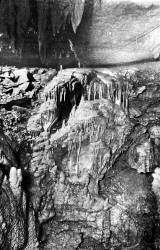
After several days of exploring in tliis region, moving rock and earth, an air vent was discovered in the floor on the south side of the pit. This opening led into a series of crevices some three feet in width and sixty feet in height which leads to what is now known as the Zigzag Stairs. Following to the north, this crevice leads into what is now known as Roosevelt Dome, but to the explorers at that time it stood as ;i bottomless pit. The scouting party was supplied with 100 feet of rope and with this Karl, who was the leader of all explorations, was lowered ninety feet. At this depth his feet rested on a ledge. He then called to the man above asking how much rope they had yet. They advised about ten feet. He called to them to pull him out, and the men thought they had at last reached one place where Earl had lost his nerve. However, lie reported to me that when standing on the ledge and flashing his light, he could still see no bottom and that he would require additional rope to reach the bottom.
We at once ordered 300 feet of rope which reached us in a few days and Karl the second time descended, finding the actual distance to the bottom 135 feet. He reported the discovery of what is now known as the Twin Domes. Other men of the party were lowered on succeeding days and several days were spent in exploring high and low in the different regions for a passage way from these vast domes to the main cave.
When all seemed practically futile, a crevice, possibly six to eight inches in width still remained unexplored. It was suggested to the smallest man of the scouting crew to attempt to pass it, but no one was willing to try it. Earl then said that he would attempt it, and by removing his outer garment and exhaling all air from his lungs he was able, by twisting and working, to slide through a distance of six feet into an unknown region, which proved to be a scries of pits and domes 110 feet in depth. On three days he made this ascent and descent through the crevice, scouting the unknown region alone. This was too dangerous, as an accident to hand or foot would render him helpless, so he was notified that some of the other men must ffo with him. At his suggestion his former buddy and friend, Carl, was permitted to go. When he suggested that Carl should go I stated that Carl was heavier than the other boys, but he said that in going through the crevice he had learned that by turning himself at an angle he could go through easier and he thought Carl could make it. Furthermore, he said that he and Carl had been together in France and if anything happened he’d know where Carl stood.
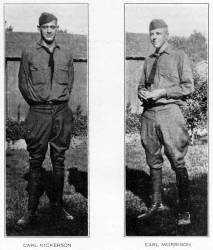
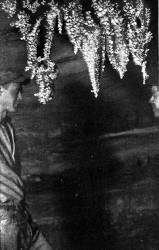
Carl joined Earl on Monday morning, passing through the crevice which was the only passage way leading into the unknown region 110 feet in depth and 150 feet in width, including two beautiful domes and a vast room now known as Solomon’s Temple. In order to be lowered to the bottom of this series of pits the end of a rope was passed through a hole not three inches in diameter and a set of pulleys lowered through the crevice. These were so arranged that the men in the first series of domes were able to raise and lower the boys in the second series of pits, but no other entrance was available except through the crevice. The second day, Tuesday, Carl crawled out through a crevice and reached a point where his passage was blocked by some loose rocks, but over them he could see a large room. He called to Earl, who was scouting in another crevice, and asked him if he wanted to look into Mam moth Cave. Earl said that he did, and Carl’s reply was to come on over. Earl made the crevice, and in order to see it was necessary to crawl over the top of Carl. Earl got a view of the vast room, and being higher and naturally more aggressive, he gave the rocks a shove and was able to dislodge several which allowed him to crawl into what proved to be the main avenue of the Mammoth Cave. Thus Carl was able to see in first and Earl was able to crawl in first.
From that date they proved the legend that no man could scout in Mammoth Cave without a guide was untrue, as they covered every portion of the famous Cave without any guide other than the survey map.
An incident occurred while they were scouting this unknown region. Another buddy of theirs who had been with them in France visited the Cave region; his name was Briscoe. lie reached the Cave region in the evening; Earl met him on the road and arranged to visit him after his Cave trip. The next morning very early he visited my room and requested permission to take Briscoe with him on the scouting trip. I raised the question about Brsicoe being heavier than either of them, but they were sure they could get him through. They did get Briscoe through all right, hut in coming hack through the crevice it required all their strength to get him out, and it was necessary to cut all the buttons off’ his military shirt and trousers.
After the boys had scouted the Cave I then decided to make a re-survey in order to check the former survey. To do this work I selected Mr. Parrish, civil engineer of Bowling Green, Ky., whose weight is 125 lbs. In my conversation with Mr. Parrish I informed him it was necessary to crawl forty-five feet, go down three series of ladders to the first level; then he lowered down 100 feet on a rope, then through the crawl-way to the main cave. I stated that one of niv men would go in front of him and one follow him, and asked him if he wanted to go. He answered that he would go — and he did go.
In making the survey the men carried blankets and food sufficient totthree (lavs and slept in the Cave. Mr. Parrish relates that on his first night in the Cave lie dreamed that he went down on a rope and landed in the hot regions; that he turned and grabbed for the rope but the boys had raised it out of his reach. When he awoke from his dream he had been scratching and clawing on the side of the Cave and, even in that cold region, the perspiration was running off of him the same as though he had been in the "hot region" of his dream. After he had completed his survey work, on making some comments on the trip into the Cave, I said to him: "But, Mr. Parrish, I told you all those conditions before you accepted this survey work." He said: "Yes, but you did not use one unnecessary word."
Cathedral Domes
By Carl T. Robertson, Editor Cleveland Plain Dealer
It was in 1907 that B. F. Eignbigler, an eminent New York engineer and Stephen Bishop, the colored guide, began their important explorations in this no man’s land to the north of El Ghor.
One of their first discoveries was Bottle Hall, where Stephen Bishop had been, and where he had left a bottle. Deponent saith noi as to what the bottle contained.
Beyond Bottle Hall they explored a labyrinth of passages where the first Bishop had never set foot, and at length came to an impressive Chamber which was named Eignbigler’s Dome, after its discoverer.
A short distance beyond Eighbigler’s dome they came to another dome, considerably larger and much more interesting. This Mr. Eignbigler named "Edna’s Dome" in honor of his sister. It is unique among Mammoth Cave Domes in that it does not dwindle toward the top. It is even conceivable that Labia’s Dome is larger at the top than at the bottom. The magnesium light fails to reveal the top clearly.
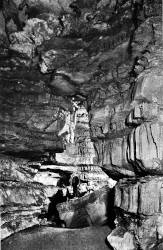
Edna’s Dome is about 170 feet high, and its grandeur rivals that of the Mammoth Dome which is shown to every tourist who takes Route 1. It is, however, far more impressive than the Mammoth Dome, for it has been left as nature made it.
Our view of Mammoth Dome is obtained from a safe wooden foot bridge with a comfortable hand rail, and the same is true of the almost equally wonderful Gorin’s Dome and Shelby’s Dome. But he who has fought his wav through to Edna’s Dome finds himself on a treacherous and chaotic mountain of rock with no haven of security. Edna’s Dome is a wet dome, with a very small, but unfailing trickle of water from roof to floor.
After the discovery of Edna’s Dome, Mr. Eignbigler and his party, which consisted of Ed Bishop and several others, paused for lunch. Edward Hawkins, a negro, who has been a guide, and who loves the cave, and who still does odd jobs about the subterranean cave property, had been the lunch carrier for Mr. Eignbigler’s party. While the others were resting after refection, Hawkins wandered about the primevial upheaval and noted a hole in the wall which could be entered only by swinging across a dangerous pit. Hawkins made a flying leap, and entered the hole.
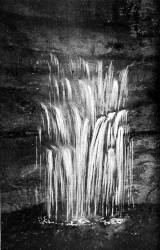
After a very short distance the hole became a high but narrow avenue. Hawkins went forward, passing a pleasing spring, and after about 800 feet entered the most stupenduous, most tremendous feature of Mammoth Cave. This was an unbelievable vast opening, a quintuple dome, since known as Hovey’s Cathedral.
Eignbigler and Bishop were not slow to respond to Hawkin’s call. They swung across the chasm, and were soon in the Cathedral which in magnitude surpasses the Mammoth Dome five times and which dwarfs even the magnificence of Edna’s Dome.
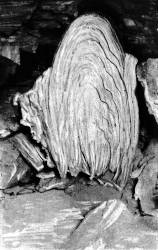
Hovey’s Cathedral is really five connected domes, but the connecting arches are so high and so massive that it seems like a single structure. The height has never been measured. It must be more than 200 feet.
When I first visited Hovev’s Cathedral I lay flat on my back on the floor while Schuyler Hunt burnt two powerful magnesium lights and I could not see the top.
The majesty of Hovey’s Cathedral is hopelessly beyond the power of description and it is equally hopelessly beyond the power of photographic reproduction. Cave photographers are specialists, and they have done very well in the business of photographing stalactites and other formations and rocky whimsies of limited dimensions. But they have never succeeded in photographing a vast subterranean chamber like the Chief City or Call’s Rotunda. In Mammoth Dome they have done creditably with details, such as the "Egyptian Ruins," but a real photograph of the Mammoth Dome is beyond the power of any photographer of the present generation.
Inasmuch as Hovey’s Cathedral is five times as vast as the Mammoth Dome, you may imagine how far it is beyond photographic possibilities.
The best that can be done is to give a vague suggestion by verbal description, of the ineffable majesty of the greatest of subterranean edifices reared by the slow hand of nature.
The Mammoth Cave limestone is stratified, and the five domes of Hovey’s Cathedral extend through many stratas. One rank may be symmetrically fluted, while the next is perfectly smooth. There is an esthetis harmony in the structure that is strongly reminiscent of the massive Gothic edifices of northern France.
The works of man may have been carried to dizzier altitudes but this work of nature is more harmoniously perfect. Its beauty is as overwhelming as its titanic majesty.
When Eignbigler entered Hovey’s Cathedral in 1907 he knew beyond question that he had entered a new place, a place of which the present generation had no record. But in the dry sand and the adhesive mud he found traces of a former explorer. Stephen Bishop had not been there; this was certain. In this direction Stephen Bishop had not been beyond Bottle Hall. But some one with bigger feet than Bishop had been in the Cathedral, and had passed in and out of it. The mystery was divertingly uncanny.
From Hovey’s Cathedral there arc but two exits aside from the entrance way from Edna’s Dome which immortalizes the name of the negro lunch carrier by its designation of "Hawkin’s Way." One of these exits is a small window high up in the side of one of the Cathedral Domes. Only one man has ever been to that window, and that man is Schuyler Hunt. He came to it by accident when he was exploring the upper levels. He describes the pass as one of the most arduous and perilous he has ever found, and declares nothing would ever tempt him to enter it again, either alone or as leader of a party. And, inasmuch as the window is more than half way up the perpendicular side of the cathedral wall, there is little likelihood that it will ever he entered from the Cathedral.
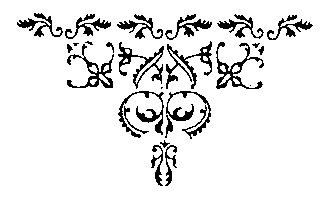
Discovers Great Pass in Mammoth Cave
The editor of the Plain Dealer recently assigned Carl T. Robertson, Naturalist, whose nature articles are known to thousands of Plain Dealer readers, to visit Mammoth Cave, eighty miles south of Louisville, Kw, for a series of explorations and studies. In the course of his explorations, Mr. Robertson has made one of the most important discoveries in the history of this great natural wonder. His story follows:
EXTRACTS— By Carl T. Robertson
On September 27th, I had the good fortune to discover what will possibly prove to be the world’s most diversely wonderful and beautiful subterranean avenue. We found ourselves at the beginning of a new discovery which surpasses in variety and splender anything else Mammoth Cave has shown.
In the vast new realm which we were about to explore no human foot had ever ventured.
As a pleasing contrast to the atrociously rough paths we had been traveling for hours the new avenue was as smooth as a dancing floor, but covered with from one to three inches of the finest limestone sand. About 200 feet from the yawning entrance we came to the first joy. This was a fairy fountain. A stream of water dropped from an invisible crevice in the roof to an almost circular bowl, six or seven feet in diameter, in a ledge about shoulder high above a natural pathway. In the upper levels of the cave a spring of this kind is a rarefy, and Schuyler and Lyman and I (piaffed and quaffed. I named it "Jane’s Fountain," for my little daughter. "How old is she?" "Six and a half. "Bring her here in two years," said Schuyler, "and I’ll take her to the Cathedral. There’ll be ladders to get her up here and she can drink from her own fountain."
But I reckoned I would wait a little more than two years before bringing Jane out over the devious and treacherous way to the "Cathedral" and over the ruggedness and pitfalls of Becky’s Alley.
Beyond Jane’s fountain we came to a region of helectites which is, I daresay, the most marvelous ever seen by human eye. I have not seen the Austrian caves and I have never visited Luray; but from descriptions and photographs, I am positive that no where else in the world is there an helictite formation comparable to that which we now gazed upon. Helictites four or five inches long are considered notable. Here was one four feet long, and it had a horizontal branch nineteen inches long by the careful measurement of Schuyler’s pocket measure. There were other helictites three feet long, with branches extending horizontal, and at every conceivable angle.
Finds Helictite Arcade

At another point there was an helictite cascade from roof to roof. There were also helictite stalagmites, a formation which I had not before noted.
These helictites are among the rarest and most inexplicable of cave phenomena. Great Onyx Cave, opened by blasting five years ago, and trying to compete with its five miles of really wonderful formations with the grand 200 miles of Mammoth Cave, makes a special point of its helictites. They were larger than any hitherto found in Mammoth Cave. The helictites of this new avenue dwarf the helictites of Great Onyx Cave into insignificance.
There were ordinrav stalactites and stalagmites also. They were not notable for size. But they were notable for their fineness of texture and the clearness of their substance.
Beyond this region we came to a region of rock flowers. Cleveland avenue, which is the gem of Route 4, the route which is supposed to give one his master’s degree in Mammoth Cave exploration, is notable for its crvstaline flowers.
Two years ago Schuyler Hunt discovered the Mammoth gypsum wall where the flowers are twice as large as the flowers of Cleveland avenue. The flowers of the new avenue are much larger, perhaps in some instances twice as large, as the flowers of the Mammoth gypsum wall. Anyway, thev are the most enormous crystaline flowers ever found. There are roses, crysanthemums, daisies, lilies. They are of a whiteness that is whiter than snow. No defiling hand, no defiling smoke from an explorer’s torch has ever dulled or cheapened them. They are as nature created them. There are oddities and whimsicalities, too. Here is an enormous rock flower, with petals rerlexed and stamens and pistil reproduced by fibrous crystals, borne at the end of a slender stem five or six inches long. Cleveland avenue can show nothing to compare with it, and the display of the Great Onyx Cave is made tame by contrast.
Other Formations Are Jet Black

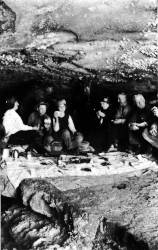
Immediately beyond the garden of snowy whiteness is a less extensive but scarcely less amazing display of jet black crystalline formation of calcium sulphate colored by manganese dioxide. Elsewhere in the cave there are blackened and grayish crystals, but a blackness that is not solid is not attractive.
The absolute blackness of these crystals is almost as beautiful as the white purity of the rock garden through which we had just passed. Instead of forming flowers, these black crystals are mostly of the so-called "fibrous" kind, forming needles two or three inches long, and sometimes so fine that the pendent masses seem as soft as the fur of an animal.
Next is the region of gigantic snowballs. In Cleveland Avenue Eddie Bransford, the Route 4 guide, shows as one of the great attractions the Snowball Room where the crystalline hemispheres are as big as half a walnut. It is the best they thought Mammoth Cave had to show in this line. Here the "snowballs" are easily a foot in diameter. There is nothing like it. It is unique.
For an easy mile and a half the three of US wandered from wonder to wonder. I was awe-struck, almost overwhelmed, by the magnitude of our good fortune. And be it said that Schuyler and Lyman were no less overcome by the diversity and the marvel of the beauties disclosed. Their exclamations were sufficient to indicate that I was not alone in being filled to overflowing with amazement and thankfulness.
Mr. Carl T. Robertson has so well described the new avenue which bears his name, first as ho states, with the sanction of A. C. Janin, acting trustee for the Old Entrance, and in honor of his achievement and as a return for his generous offer of any of his manuscript, the New Entrance Management decided to accept as due to the discoverer that the name of the noble avenue should immortalize the name of Robertson.
In acceptance of his kind offer, extracts from his copy are here used in description of Robertson Ave., Cathedral Domes, and various places in Manmoth Cave. These articles were written while development work was in progress at New Entrance before New Entrance was open to the public. Mr. Robertson was a guest of the Old Entrance and wrote his article as an explorer from Old Entrance so he is another Old Entrance witness and they must abide bv his testimony.

A Visit to Mammoth Cave
Via the New Entrance
Departing from the Union Station, Tenth and Broadway at 8:25 A. M., we arrived at Cave City at 11:80, stopping at the Dixie Hotel for Lunch. This proved to be one of those famous lunches which makes the Dixie Hotel the mecca of Kentucky traveling nun. The Hotel management arranged for our trip to the NEW ENTRANCE which is situated seven miles out the Barren County pike from Cave City. Immediately after our lunch the Auto Bus, maintained by the NEW ENTRANCE, was announced in readiness for the Cave trip.
Some thirty minutes was required to make the bus trip from hotel to cave entrance which is situated in the depths of a marvelous depression of the earth’s surface. This depression is in the shape of a horse shoe. On three sides it is walled by nigged rock cliffs (that is, on the East, North, and West; on the South the surface has been erroded or carried away until an easy approach has been effected. By grading auto roads down the side of the cliffs to the location of the Cave office and cottage, no obstacles remain to deter the visitor. These buildings are situated on the southern wall of the depression and not over twenty feet above the base of the depression while on the other three sides the depth from surface to bast’ is eighty-five feet, and it is three hundred feet across at the surface and thirty feet across East and West at the bottom.
This great irregular bowl forms a natural amphitheater, walled, as stated, by rugged rock walls all covered with wild vines and foliage. From top to bottom the sides are covered with a profusion of wild Mowers. Ferns are seen everywhere, thrifty and beautiful. Beautiful because of their wildness and natural growth, which each year increases in number and variety. It is reported a task to protect them from the lovers of flowers as the surroundings are so natural to the wilds that the visitor is unconscious of the fact that he is not in the depths of the wilds and welcome to an armfull of ferns.
Standing at the bottom and near the center of this oval is a beautiful poplar tree, a monarch over one hundred feet in height and nine feet in circumference at the base and some fifty feet to the first limb. This tree is remarked by every lumber man who visits the Cave, and is coveted by every timber man in the Cave region. Covering the base and sides are numerous trees — hickory, poplar, oak and chestnut. Many of these trees are covered with wild vines and grape vines are numerous and stupenduous. In size, some vines equal the size of the ordinary fire hose one sees on the street when the fire department is battling with a fire.
The foliage of the trees and vines form a canopy over this oval that the sun is scarcely able to penetrate only at high noon and then only at the opening of the Cave. The balance is all a shady dell, alive with wild birds and squirrels.
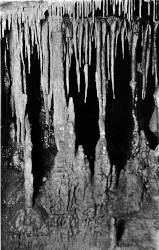
The Cave office and cottage were erected among the trees. Trees are growing thriftily through porches and roof. All are in a dense shade, cool and comfortable. At the Cave office one registers. This is required so the Revenue Inspector can assure himself that the Government receives their tax on all who visit the Cave. It is also believed that in say, three thousand years, these Cave registers will have great historical value. Be that as it may, you are also supplied with a cave suit at the office and if you wonder off the well-beaten paths in the cave or arc tempted to crawl into some of the smaller crevices to set’ some special hidden beauty you will realize that the cave suit had some present value in the preservation of your traveling suit.
After registering and securing cave suit we are now provided with an admission ticket for which is charged the sum of two dollars and twenty cents, the twenty cents being Government or War Tax. Thus equipped we are instructed to pass down the slope and rock steps to the entrance where the guide, equipped with powerful gas lanterns and emergency lanterns, awaits the party. Upon the arrival of the party the guide collects admission tickets and is informed as to route to be traveled, He then forms his party in line, placing those who are aged or frail at the front so they will be under observation more than they would be if at rear of ranks.
The Cave gate unlocked and opened, we are now ready to view the underground wonder.
Leaving the base of the great oval we pass through a small pit. Turning sharply to the right we enter a narrow passageway and are surprised to find a flood of electric light illuminating our passageway. Following the narrow passageway for some forty feet, we come to a rocky room on the right. This lias been named the "President’s Room," due to the fact that while the exploration and construction of the New Entrance was in progress the president of the company used this room for headquarters. The temperature is even and the air dry and bracing. Turning to the left and, as one passes down a flight of steps you are instructed to look down to the right. Here through a small opening you can see electric lights strung down and down through space and still extending downward. You have had your first glimpse of the great Roosevelt Dome. Passing on from the top of the dome the way leads to the left through a crevice of sufficient width for two to travel abreast and fully forty feet in height. This was the main water channel that carried the volume of water to carve out the majestic dome. This crevice Leads to a T-shaped dome. In this dome has been placed thirty-five steps known as the Zigzag stairs. Down these one passes to the second cave level and passing to the left some forty feet reaches the top of what was known as the seventy foot pit. But, in order to reach the lower levels it was necessary to sacrifice this pit, so one finds, instead of a pit, a substantial stairway of forty-six steps, leading to the lower level. At the foot of the stairs the passage bears to the right and is narrow and requires stooping and care to negotiate. After passing through, the guide will call your attention to the Needles Eye, through which you have just passed. You have now entered the Jaw Bone Dome, so called for the jaw bone that is shown imbedded firmly in the floor of the dome. This specimen, with the teeth attached, caused considerable speculation as to the kind of animal and how it was possible for it to reach that spot, etc. Many Naturalists have viewed the relic — none have offered a positive theory.
Passing on we enter the Crescent or Fossil Dome. This is a beautiful crescent-shaped Dome and abounds in fossil, so either name is appropriate. Leading out of the dome are the Winding Stairs, so named as they wind down through a narrow crevice at the top to land at the portal or entrance to the Twin Domes (at the bottom). So far no one has questioned the propriety of calling this flight the Winding Stairs. On arriving at the entrance to the Domes the Guide announces the arrival of visitors by striking a projection of the wall with a wooden mallet. This produces a sound similar to the Chinese Gong and is the only place known in the vast cavern where the true limestone produces a musical sound. After listening to the Gong, we pass to the right through a solid passageway into Roosevelt Dome. Passing across this dome to the right your attention is called to the most beautiful pool in Mammoth Cave. This Pool is located in a recess of its own.
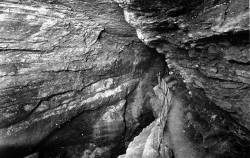
The entrance to the Massive Dome is four feet in width and ten feet in heighth and the pool is situated in a small dome some ten feet in diameter and twenty-four feet in heighth. It is floored with a water basin the full size of the dome, making a pool of sparkling cool clear water twelve inches in depth and which hears the title of the Fountain of Youth. While it may not renew all lost energies of youth, a cool refreshing draught certainly aids the traveler who is ascending the steps.
Having enjoyed a refreshing drink and admired its setting, your attention is called to the wonders of the dome. By looking up when standing in the entrance to the pool you can see the lights and the support placed at the top of the dome to which your attention was called when you were passing down the second Might of steps. Here you can see the lights placed at intervals from bottom to top of dome, the distance of one hundred and thirty feet — all is a blaze of light and you can gain some faint conception of the might v task accomplished by the action of water in cutting out these great monuments signifying its irresistibility.
After viewing with wonder this great height, you are requested to step across to the opposite side of the Dome where, by placing your back against the wall, you can look up and see the true shape of the dome which you will he surprised to see is a perfect heart shape, enormous in si/e. Now passing out of the Dome you are requested to look at the walls of the Dome.
Soon your gaze rests on a projection some thirty feet above which you readily recognize as a perfect profile of Theodore Roosevelt. With the profile in view the mind soon wanders hack to the shape of the Dome which is Symbolical of the big heartedness of one of America’s most loved citizens and, as to accentuate more strongly the character imputed to this illustrious statesman, the explorers have left in full view a small pole. It was used as an aid in crossings dangerous crevice and owing to the inaccessibility of its location, it is safe to say that it will remain for ages unmolested and will be pointed out as representing the Big Stick of political fame.
Pondering the marvels revealed in Roosevelt Dome, we pass through the other entrance and are amazed to find ourselves, after having passed only a few feet through a narrow passageway not over twenty feet in height, to have entered another dome of equal height and dimensions of the Roosevelt Dome, brilliantly lighted by well placed electric lights. The wall of this twin dome is equally as interesting as the other dome. The relief of any ancient ruins that conies to mind the fae-simile can be readily found in the grotesque formations that the action of the water has left on the wall, the dripping water has left the most indescribable conglomeration of forms decorating the wall of this dome that has been discovered anywhere in the cavern.
Passing from this dome and down ten steps we reach the top of the 110-foot dome. This dome is noted for the symmetry and regularity of the walls. The Dome is sixteen feet in diameter and does not vary from top to bottom; is as true and perfect as though made to measure. It was found necessarv to build a flight of steps across this Dome and seek a landing for timbers on the opposite side. These steps in a sense handicap the view of the Dome. Having viewed the Dome while coming down the steps and reaching the opposite side of the Dome, we are now at the top of another night of steps, twenty-one in number, leading to the Camel Spring. Here, in what was formerly a small Dome, the side of which was removed to make possible the steps, issuing from the center of the roof of the dome is a small stream of water, clear as a crystal, cool and refreshing. The guide will call your attention to a limestone projection, resembling a camel at rest. From this it derives the name of Camel Spring. Passing from the dome and practically under the step just descended, finds you at the top of the last night of steps, The Giant Stair Way, consisting of twenty-six steps, these steps lead into Solomon’s Temple. This vast temple is one hundred feet across in many places and its greatest height is 1()7 feet. The steps do not lead to the bottom of the Temple, but land OBt a huge rock in the center and a substantial bridge or walk leads to opening in the side wall of the Temple. From the bridge one can view the depths, some forty feet below, and can see and hear the water rushing on down to lower levels. This Temple taxes the human language to describe. On reaching the walk and viewing the Temple at all angles one is at a loss how or where to start to attempt to give a description of the impressions created. The water has left the wall in an arregular shape. On the wall to the right of the bridge and above some thirty feet, the walls are fluted, flounced, flared and frapped, and as one studies the different contours, the miniature of cities, ruins and homes come into mind, and different persons point out different views, each one clearly visible when attention is called to it.

Passing across the bridge we now cider a natural subway, cut by the water through the solid limestone. This subway gives the impression of the inside of a Sleeping Car, when used as a parlor car with the berths all closed. It is ten feet wide and of equal height in the center. The sides are regular and sides and floor are incrusted with a greyish lime formation, and all are requested not to mark the walls. Some have already added their names to the list of cave names, so it seems necessary to renew the request on each trip not to write names in the New York Subway. Passing out of the Subway one mounts a short flight of steps, and is amazed at the magnitude of the underground opening he has entered. Allowing a few seconds for the visitor to form some idea as to the vastness of this great chamber, the Guide then informs you that you have entered the main avenue of the World’s Famous Mammoth Cave. This is the terminal of the present electric light system for lighting the cave. Also, it is the diverting point for all the different cave trips, so has drawn the name of Grand Central Station, as it is fitting that the New York Subway should lead to the Grand Central Station, and that all routes should start from a central station.
THE LADY OF THE CAVE
See The Little Girl Turned To Stone
Shown At The End Of Each Trip
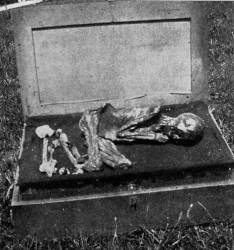
A little girl petrified or mummified by the action of the Cave air. Note this is not a skeleton as the outer covering, skin or cuticle remains intact covering the skeleton completely except where broken or damaged by accident.
This, the most interesting and most wonderful of all the numerous Cave phenomena, was found in "Salts Cave" by Messrs. Lee and Cutcliff in 1875. During the 4 years since the discovery, it has been exhibited in the Smithsonian Institution, Washington, D.C., and at various other places by Mr. H.C. Ganter, the former owner, and is now exhibited at New Entrance.
An abundance of hair, auburn shade, believed to have been red hair, was found with the body. Burnt reeds, the remains of the Indians’ camp fire; also worn out Indian moccasins, with other debris, prove that the Indians inhabited Salts Cave.
It is believed that the Little Girl had been captured by Indians, and rather than endure their torture she sacrificed her life.
Mammoth Cave
In the Old and out at the New
To set at rest all questions as to the New Entrance leading directly into the famous Mammoth Cave, the above map of the traveled routes of Mammoth Cave is hereby submitted, together with photograph of a party of fourteen people, who on August 15, 1923, entered the famous cavern at the old entrance and passed out at the New Entrance, having travelled the underground route from the Old Entrance to the New Entrance in seven hours.

|
KEY TO MAMMOTH CAVE MAP OLD ENTRANCE 1 Iron Gate 2 Houchin Narrows 3 Rotunda 4 Bat Avenue 5 Gothic Avenue 6 Giants Coffin 7 Dante Gateway 8 Rocky Mountains 9 Specimen Avenue 10 Maelstrom |
KEY TO MAMMOTH CAVE MAP:- NEW ENTRANCE 1 Twin Domes 2 Massive Gypsum Walls 3 Ancient Walled City 4 Grape Formation 5 Watch Tower 6 $100,000.00 Formation 7 Fairy Fountain 8 Beck’s Alley 9 Robertson Avenue 10 Mammoth Gypsum Walls 11 Devil’s Bathtub 12 Eignbigler Dome 13 Tobacco Leaves 14 Forks of the Cave 15 Saratoga Springs 16 Cox Entrance |
FROZEN NIAGARA OR ONYX AVENUE 1 Roosevelt Dome 2 Grand Central Station 3 Big Break 4 Lovers’ Leap 5 Cave Crossing 6 Fairy Ceiling 7 Fountain 8 Onyx Colonade 9 Earl’s Bath Tub 10 Roy’s Dome |
New Entrance and Old Entrance
Statement by Geo. D. Morrison, President of the Mammoth Cave Development Co.
In fairness and in justice to the hundreds of citizens of Kentucky and Indiana, who are investors, and who are interseted in the activities of the Mammoth Cave Development Co., of which I am President. I feel it has become my duty to answer the numerous misleading statements that have been uttered by the management, representing the Old Entrance, and as I can conceive of no better plan to destroy a misleading or false statement than to tell the truth about it. I will confine my statements to the truth relative to the New Entrance and the Old Entrance to Mammoth Cave.
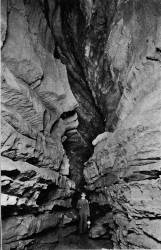
As to the statement that the ’’Old Entrance is the only entrance to Mammoth Cave"’ and the attempt to justify this statement by the argument that the hundreds of miles of underground passageways that compose this vast cavern are or can be restricted to the number of acres of land formerly owned by Doctor Croghan and willed by him to his eleven nieces and nephews is seen to be both misleading and fallacious, as sworn affidavits and signed statements of different tourist parties, who. having passed into the cave at the Old Entrance have made the continuous trip from the Old Entrance and out at the New Entrance. The time required to make the complete trip varies from five to seven hours. This proves the statement that the New Entrance leads, through the greatest series of pits and majestic domes ever discovered, as directly into the main avenue of Mammoth Cave as does the Old Entrance lead through Houchins Narrows into the main avenue of the famous Cave.
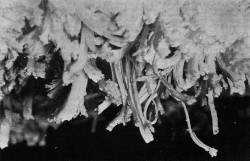
As to restricting the Cave to the land owned by the heirs of Dr. Croghan, this would reduce Mammoth Cave to at least fourth in the list of known caverns. The Collossal Cavern, located one and one-half miles east of the Old Entrance, would outrank Mammoth Cave as well as would the wonderful Wyandotte Cave of Indiana and the formidable Nicajack Cave of Tennessee, as well would the New Entrance then outrank the Old Entrance is mileage as it does now outrank it in the beauty of the formations shown and in interest and wonderment in the points of interest shown. To restrict Mammoth Cave and build a wall at the boundary line would limit the Cave to two main routes or avenues, namely the avenue to Star Chamber and \ iolet City and the Long or River Route, and as the measured distance from the Old Entrance to Violet City, pass the Star Chamber is only two miles, and the distance that can be traveled on the Long or River route before reaching the boundary line is less than three miles, this would be a big reduction from the fourteen miles as advertised for the long trip, and would call for the wall to be built at the point now shown as Victoria’s Crown. Tins would shut off the Mule Stall, Black Hole of Calcutta before reaching Mary’s Vineyard as well as all the beauty of the Old Entrance which is practically restricted to the beautiful avenue leading from the Vineyard to the Maelstrom or the end of the Long Route. So it can be clearly seen that restricting the Cave as suggested would reduce the Long or fourteen mile trip to a six mile trip and denude it of all beauty and formation and reduce the cave from a .Mammoth Cave listed as one of the World’s Wonders to a mediocre cave, at least fourth in the list of caverns, with only two traveled avenr.es, whose combined length only equals five miles, as against the two hundred miles of underground avenues they advertise in their literature. Thus it can he clearly seen that the intention of the assertion was only to mislead the tourist as the suggested wall woidd no more limit the extent of the famous cavern to their land than their statement that it was so limited. It would be just as logical to say that in order to see Tennessee River one must go to Tennessee or to see Green River one must travel to Green County.
As to tourists being deceived by New Entrance. This is as misleading as the other statements, as painted on the sign in full view of every tourist is the following: "NEW ENTRANCE TO MAMMOTH CAVE, Lighted by Electricity. Has No Rival." This sign is sixteen feet in length and the letters are eight inches high, so all can read and it is placed so as to he read before the tourist turn off Cave City road to New Entrance, also the Old Entrance has a painted sign at the turn in the road, setting out the tact that the Old Entrance is three and one-half miles beyond. Also our printed literature is submitted, which plainly sets out the fact that this is a NEW ENTRANCE to MAMMOTH CAVE and specifically names the points now shown from the New Entrance that were formerly shown from the Old Entrance and I personally paid Cave fees to the Old Entrance to hi- shown the points named, which are as follows, viz: Alice’s Grotto, Devil’s Bath Tub, Forks of the Cave, Saratoga Springs, Boone Avenue, Tobacco Leaves Martel Avenue, Pinson’s Pass, Brans ford Avenue, Eignbigler Dome, Edna’s Dome, Hawkin’s Way, Hawkins’ Spring and the Cathedral Domes, and description of most of the points will be found on pages 95, 96 and 97 of the official Old Entrance Guide Book, also an extract from the articles written by Carl T. Robertson, Naturalist and Discoverer, and published in the Cleveland Plain Dealer, is submitted.
In at the Old, Out at the New Entrance of the "World’s Famous Mammoth Cave"
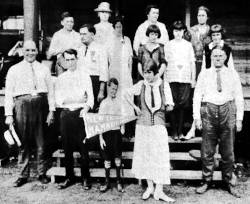
Added proof of the accuracy of the statement that the New Entrance leads as directly Into the Mammoth Cave, through the greatest series of pits and domes ever discovered into the Main Avenue, as does the Old Entrance lead through the narrows into the Main Avenue, is furnished by the following affidavit of five persons who passed in at the Old Entrance and came out at the New Entrance of America’s "Greatest Natural Wonder":
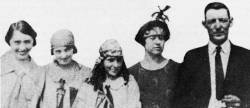
Affidavit
This is to certify that we the undersigned did at 9 a.m., the 23rd day of July, 1923, visit the Old Entrance, and purchase tickets for what is known as No. 4 route, equipped with lanterns, and with Leslie Coatcs for guide, we started our trip through the Iron Gate, through the Cork Screw, across Echo River, on to Martha’s Vineyard. At this point we came upon J. Rutherford, Pete Strange and Claud Monroe, who had entered the Cave from the New Entrance; they proposed that we extend our trip and come out with them by way of New Entrance. We all accepted the offer and passed on from Martha’s Vineyard through Boone’s Avenue, to Pinson’s Pass, to M artel Avenue, to Bransfords Avenue, to Edna’s Dome, to Eignbiglcr Dome, to Hawkins Way, on to Hovey’s Cathedral Dome. All of these points from Martha’s Vineyard are described and shown on the maps, in the Old Entrance guide hook.
From Cathedral Domes we traversed Robertson’s Avenue, which was discovered by Carl T. Robertson, accompanied by guides from the Old Entrance, and from Robertson’s Avenue we passed on to and out of the New Entrance of Mammoth Cave, having traversed the underground Avenues from the Old Entrance to the New Entrance in 7 hours, passing out at the New Entrance at 4 p.m.
Signed, this the 23rd day of July, 1923.
W. J. Boyle, Scaly, Texas.
Mrs. Wm. J. Boyle, Scaly, Texas.
Cornelia Slaughter, Dyersburg, Tennessee.
Ruth Hike, Dyersburg, Tennessee.
Deborah Poston, Dyersburg, Tennessee.
Subscribed and sworn to before me, this the 23rd day of July, 1923.
Pleas Sanders, County Clerk of Edmundson County.
By J. H. Borden, Dep. C. C, Ed. Co.
New Entrance to Mammoth Cave has been investigated at our request and approved by the following:
Wm. M. O’Neal, Proprietor of Dixie Hotel, Cave City; Joplin Hotel, Elizabethtown.
Representatives of the Louisville and Nashville Railroad Company.
Representative of Banking Commission, Frankfort, Ky.
Representative of Banking Commission, Indianapolis, Ind.
Representative of the Louisville Herald.
Representative of the Louisville Post.
Representative of the Louisville Times.
Representative of the Evansville Courier.
Representative of the Evansville Press.
Representatives of the Louisville Hoard of Trade.
Morrison Avenue
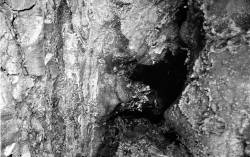
On September 25, 1921, Karl Morrison, by working his way, moving loose rocks and dirt and crawling through beyond where other explorers, namely, Bishop and Kemper, had stopped, as shown by their names, advanced and discovered the avenue which now hears his name -Morrison Avenue.
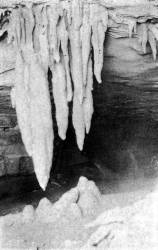
This avenue leads off the main Cave avenue to the south between the points known as Alice’s Grotto and the Mammoth Gypsum Wall, and into a vast Gypsum deposit where the avenue is sided, ceiled and floored with beautiful snow white Gvpsum deposit. A portion of this is known as the Cotton Belt Route; Flanders Field: Ruth’s Dome; Snow Ball Room and the Flower Garden where you can find any flower that grows, duplicated in this wonderful Gypsum formation. The discoverers found that in a new Gypsum avenue at least four layers of this Gypsum formation had fallen to the floor. It is supposed that the great weight accumulated in the growth of this wonderful formation had torn the layers from the ceiling and it is now deposited on the floor. The thickness of these four Layers on the floor is usually about sixteen inches, which it is necessary to remove or to cut a pathway through in order to admit visitors. What seems very remarkable is that these formations, although falling from the ceiling, yet preserve the most delicate Mowers uninjured. This can hi’ seen by the remarkable pieces that have been removed and are now exhibited by the side of the pathway.
Passing from the Gypsum region one enters the Onyx region. First is the Onyx Shrine, next the Onyx Draperies which are unexcelled in whiteness and purity. Leading 1 to the north is the corridor which leads to Elizabeth’s Parlor. This corridor is about five feet in height and eight to nine feet in width and is filled with an Onyx formation. The floor is lightly sprinkled with light brownish sand and the walls and ceilings encrusted with a greyish lime. This corrdor is as true and symmetrical as though cut out by masons. It is certainly indescribable the sense and feeling of walking out this corridor where you can see and know that no human foot has ever proceeded you. This avenue will stand comparison with any cave avenue ever discovered.
New Entrance Cave Routes
ROUTE NO. 1 — MORRISON AVENUE AND ELIZABETH’S PARLOR
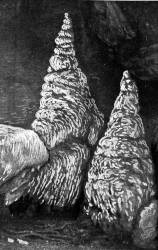
Forty-five feet from the New Entrance Gate, a visitor reaches the top of ROOSEVELT DOME, by the aid of the electric lights placed at intervals from top to bottom this great dome one hundred and sixty five feet in height is viewed by the visitor as a vast pit, outranking the famous bottomless pit, which is only ninety seven feet to the bottom. Passing down four different flights of steps, passes down from one cave level to another, until the bottom of this marvelous pit is reached. At the entrance to this dome is viewed the correct profile of one of the most loved American citizens for whom the dome is named and, nature, not satisfied with only leaving his profile, has left the dome heartshape, emphasizing the thought that all associated with Teddy, namely. Rig Heartedness, and the early explorers not satisfied with what nature had done, they accidently left, a "Big Stick" across a fissure up some forty feet in the side of the dome. This stick was an aid in crossing the fissure, and was left there and as it is out of reach of all but an intrepid explorer, it will remain there for ages, as an aid in emphasizing the traits of the man for whom the dome was named.
Leading to the west from Central Station the pathway leads under a vast mountain of fallen rock following a natural water channel which was left unobstructed. We pass from this into the vast New York Hippodrome which is 250 feet in width, .’300 feet in length and 85 feet high, showing three distinct levels of the Cave. On the right wall of the Hippodrome will be shown the wonderful Gypsum flowers, jointed snake discovered by Mr. Bullitt, diamond vale, the Hand Writing on the Wall, and the letters A. R. K. Passing through the Hippodrome by a series of flights of steps at intervals, you then pass to the top level of the Cave. You are now directly under the New Entrance Hotel and that point designated for the elevator shaft to reach the Cave. Passing on west from the top level you enter the Colossus of Rhodes, noted for the skyblue ceiling. Then conies the Aero Bridge. This is a 800-foot wire cable supported from one cliff to another across a vast canyon 125 feet deep and 75 feet wide. On this wire a car was swung to transport materials across this canyon and a considerable number of people have taken advantage of the opportunity to have a ride in this car 300 feet underground. On the right of the Aero Canyon your attention will be called to the Indian Chief, Pocohontas. This is due to a light placed in a certain position throwing a reflection which forms a correct profile of an Indian Chief wearing a war bonnet with feathers. This was discovered by Carl placing his lantern on a ledge while at work, and lunch being called, he went over to the side of the canyon to eat his lunch without taking his lantern, and, looking back from a distance, discovered the profile caused by the reflection of his light.
Passing from Aero Canyon the way leads to a higher level of the Cave through Register Hall where notable people have already placed their names on the deposit known as White Onyx. From there your attention will be called to the Indian Flint; also to the President’s Ship, the Mayflower; then on the right passageway the oldest fort in the United States, St. Augustine; then on to the Hanging Gardens; then across Horse Shoe Bridge; then on to a grotto named the Watch Tower with two stalagmites standing as sentinels. Inside of this grotto you will be shown an imitation of strips of bacon; Martha Washington’s Statue; Elephant Head and Onyx Shawl.
From this place you will pass along a narrow pathway to the edge of Live Man’s Gulch, over the Bridge of Sighs. From here you will look down to the lowest depth or level of the Cave, which has been designated as the Depths of Despair. You now pass on the Cliff Walk which is 150 feet long and 85 feet from the bottom of the Grand Canyon. On the right you will find placed in the wall a profile of Jiggs and Maggie, and by looking down at a great distance you call see that they "brought up Father."
Passing from the Cliff Walk you re-enter the Main Avenue of the Mammoth Cave at what is known as the Black Onyx Room. You now enter the Arena, ascend to Gypsum Hall, and here is the only place in the world where you can be shown the Black Gypsum Needles. On the wall you will see a map of South America. You will now descend Mt. McKinley and will be shown the one and only Black Gypsum Sunflower; on the right you will be shown the Mammoth Gypsum Walls, and here are exhibited the largest Gypsum flowers ever shown, 335 feet below the earth’s surface. Your attention will be called to the polka-dotted ceiling, guinea hen, sea gull and letter M; also to a 100foot groove right in the ceiling.
You now pass through the region known as the Ruins of Martinique. Here you are shown the bones of a pre-historic animal. Farther on you will be shown White Onyx drapery on the wall: also the natural water way in the ceiling witli water lillies on it; then conies the frosted ceiling; then you climb Ochre Hill. From this point you enter the New Discovery— Morrison Avenue.
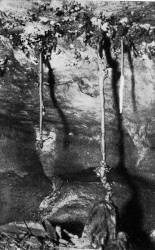
The most beautiful underground chamber ever discovered. Floor, walls and ceiling encrusted with a greyish lime formation and decorated with silver tipped helectites and crystalline flowers. Shown from the New Entrance to Mammoth Cave.
Named tor Mrs. Elizabeth Morrison, wife of Geo. D. Morrison the discoverer and founder of the NEW ENTRANCE TO MAMMOTH CAVE.
The first to attract your attention is the White Ceiling, colored Gypsum, potato patch, tall man’s delight, criss-cross ceiling, pink Gypsum, art gallery, crochet designs, cotton belt, Zephyr Gypsum, Ruth’s Garden, Ruth’s Dome, Bridal Wreath, Toasted Marshmallows, Peanut Candy, Coon Tracks and Skeleton, Onyx Shrine, Leaning Tower of Pisa, Carrots, White Onyx Drapery, Steamship Maryland, imitation of pie-pan, Japanese Flint, Ochre Urn, Giraffe Head, Lovers’ Lane, Petrified Alligator and Elizabeth’s Parlor.
ROUTE NO. 2 — ROBERTSON AVENUE AND CATHEDRAL DOMES
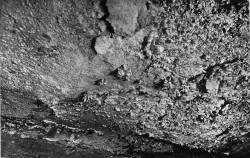
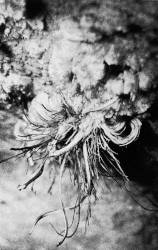
This route leads through Robertson Avenue to the celebrated Cathedral Domes which were shown for many years from the Old Entrance and which required at least eleven hours of continuous travel to make the trip. These are now shown exclusively from the New Entrance, requiring only 2 1/2 hours to make the trip.
Passing out of Grand Central Station and descending the great stone stairway that leads to the north over the Big Break, the path leads into a limestone channel. The floor is smooth and is covered with a deposit of Ochre, of which great deposits abound in the Cave. Passing a short way through this avenue we come to the big Gypsum Wall with its countless Moral reproductions. Here the mineral flowers range from a tiny sparkling formation to colossal flowers measuring from 18 to 22 inches in diameter. The White Swan, a most remarkable formation of White Gypsum is next seen. So strikingly plain is the likeness to a swan roosting overhead that often a second glance is required to be sure that a stuffed bird has not been placed there.
The path continues between the limestone walls in an ever winding, ever changing crevice to Fox Avenue, so named due to the finding of the remains of three foxes at the extreme end of the terminal of this avenue. Evidently these animals found their way into the cavern from some other point and following this avenue to the end which is completely scaled, they wire unable to find an exit. The three being found in close- proximity brings up the question — a fox track will remain for ages as plain in the cavern as the day made, and the question is, does the scent remain also?
Fox Avenue is a lofty corridor from U to 1 feet wide and about 500 feet long which leads into New Avenue discovered in 1921 by Carl N’icherson and Carl Hanson and now known as Carl Avenue. This avenue starts on a higher level than Fox Avenue and the floor is covered with Ochre, making walking as easy as on a well worn path.
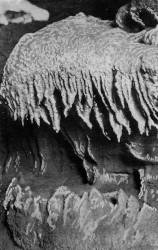

This pathway leads across Natural Bridge. Here the water has cut away the stone leaving a deep pit spanned by a natural bridge of rock. Passing over this bridge and through the crevice to the left leads into Robertson Avenue.
This discovery of Carl Avenue connected Cathedral Domes to the New Entrance by the way of Robertson Avenue, reducing the time required to make the Dome trip from ten to two and one-half hours.
Entering Robertson Avenue this route leads past many points of interest fully described in Robertson’s description of his discovery and are set out as follows :
Snow Rail Room in which the ceiling is studded with immense white deposits that look as though huge snowballs had been thrown against the ceiling.
Leaving the Snowball Room we soon come to another Gvpsum Wall which, while not as large as the one passed soon after leaving the Grand Central Station, is nevertheless of great beauty in its white and soft gray coloring and delicate and fragile formations. This is soon followed by the wonderfully beautiful Black Gypsum deposits. So far all the Gypsum deposits have been either of white or soft gray coloring, but here is found a deposit of this wonderful mineral in all the varying shades of black, giving it the appearance of having been badly smoked. This, however, is but one of the many illusions of the Cavern, as no torch has ever been carried through this avenue, the coloring being entirely due to the chemical nature of the deposit.
At this point a distant rumbling is heard. For a few moments you are unable to tell from what source this sound comes; however, as we continue along the path the roar of rushing water is plainly recognized. This is the first evidence of the approach to the mighty Domes.
On the ceiling to the left is found the most magnificent flower ever exhibited in any cavern — a perfectly pure white lily clinging to the ceiling by a short, slender stem, formed of snow white Alabaster. Each dainty petal of this wonder flower stands out separate and distinct and they are about six inches long and three inches wide at the tip. This has been named the Tiger Lily.
Passing on, the Avenue here has reached a width of some 30 feet and 12 feet in height. The floor is covered with two or three inches of brown sand; the walls and ceiling are encrusted with a grayish lime. Portions of the ceiling are highly colored and this has been named bhe Marshmallow Ceiling, due to this coloring. The distance covered hv this fantastic ceiling possibly equals the distance of a city block.
Passing from this region one is amazed to find placed in the center of this avenue the largest Helectite known. This Helectite is two feet in diameter at the base and extends six feet in height, with a horizontal arm extending 19 inches. This has been named the $100,000 formation, as it is the master Helectite of all cavern regions.
On the right wall is an Onyx Cascade reaching from the ceiling to the floor. Passing this we come to the Fairy Fountain and the Democratic Rooster — he is buried now, but they say he will come up. Passing on we descend into Backy’s Alley or the Narrows. This has been designated as a River on Edge. It is a magnificent crevice 60 to 80 feet in height and from 18 to J30 inches in width, leading directly into the series of domes known as Cathedral Domes. This, without doubt, has been the main passageway carrying the water to or from the Domes which carved out these monsters.
ROUTE NO. 3 — COMBINING ROUTES ONE, TWO AND THE LOOP — THREE CAVES IN ONE
Showing all the vastness, beauty and grandeur of the Mammoth Cave, Onyx Cave and Crystal Cave in one.
After enjoying the complete Number One trip, as described* and returning from Elizabeth’s Parlor to the main eave, you can start on the Loop trip, turning left in the main cave, then traveling over wild rough cave for a short distance which brings vou to the wonderful Gypsum walls, covered with beautiful Gypsum flowers — then on to "’Alice’s Grotto." This Grotto was formerly the turning point for visitors from the Old Entrance. Only real cave fans cared to extend the trip beyond Alice’s Grotto as it required eleven hours to visit this point and return to the old entrance.
From Alice’s Grotto you follow the old worn path, made by visitors from Old Entrance, on to what is known as the devil’s hath tub. From this point the cave is smooth and the floor covered with sand, resembling an old abandoned river bed. This smooth floor continues until you come to the forks of the cave where the main avenue is filled with red sand and a smaller avenue branches off that leads past "Saratoga Springs," a delightful place to drink. The walls are encrusted with a grape-like formation. This avenue continues on to Boone Avenue and following Boone Avenue to the left leads to Martha’s Vineyard. On past Martha’s Vineyard the avenues lead directly to the Old Entrance.

A.L. Neville
Geo. W. Yarrail
Mrs. Geo. D. Morrison
Mrs. Geo. W. Yarrail
Wm. Freeman
Miss Breaden
Lacy Neville
Peter Strange
Carl Nickerson
Jack Chapman
Geo. D. Morrison
First cave party Robertson Ave.
On reaching Boone Avenue and turning to the right this brings one to the formation known as the Tobacco Leaves; from the Tobacco Leaves you follow the old route described in the Old Entrance guide book, via Tobacco Leaves, Martel Avenue, Pinson Pass, Branfield Avenue, Eignbigler and Edna Domes and Hawkiifs Way to the Five Monarchs and "The CATHEDRAL DOMES." From the Cathedral Domes you cover the Number Two trip as described heretofore.
This Loop Route requires at least five hours.
ROUTE NO. 4 — FROZEN NIAGARA OR ONYX AVENUE
IN AT ONE ENTRANCE, OUT AT ANOTHER
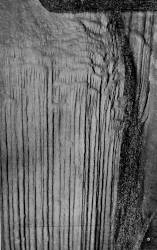
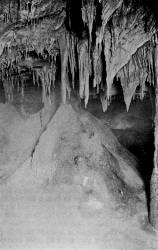
FROZEN NIAGARA or ONYX AVENUE recently discovered and open to the public, exhibits vast depoits of Onyx and format ions of every character, from the massive curtain-like structure that resembles the mighty Falls to the most delicate stalactites not larger than a sewing needle.
A tour of Onvx Avenue brings into view cave formations that are unsurpassed in beauty and magnificence. Passing Lover’s Leap, The Compass Needle and the Fountain the vast onyx deposit just beyond is revealed in all its splendor. This grand deposit extends over three cave levels and is formed into numberless indescribable shapes. Niagara Falls done in Onyx, Old Tuts Tomb, Onvx Colonade, Hindoo Temple, Onyx Drapery, Onyx Stalactites, Egyptian Pyramids, "Gideon’s Fleece." are all shown on this trip.
After revelling in these Onyx Chambers to the hearts content there is no long, hard trip to retrace as this route emerges from the entrance into the beautiful Dovcl Valley where autos are in waiting. With no change of earincuts necessary.
ROUTE NO. 5. — DELUXE TRIP OF MAMMOTH CAVE
COMBINING ROUTES ONE, TWO, THREE AND FOUR — TWO ENTRANCES ALL IN ONE — NO RETRACING
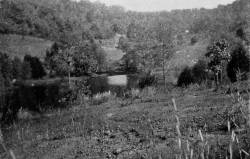
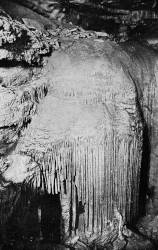
You pass in at New Entrance and emerge at entrance to Onyx Chambers.
A nine-hour trip always going forward with no retracing. The eye finds something new every second. In at the New Entrance, down through the marvelous pits and domes, brilliantly lighted by electricity, on to the Main Cave. Then on to Morrison Ave., then Elizabeth’s Parlor, visiting the Loop, on to the majestic Cathedral Domes, enjoying the beauty of Robertson Ave., the Mammoth Gypsum Walls, the Big Break, then through Onyx Ave., to the Onyx Chambers. Here you can attempt to form a describable impression of the wonders that an unseen force has brought to view and if you are successful, you win the NEW ENTRANCE CROWN. From Onyx Chambers you emerge at the Entrance to the Onyx Chambers, leading into the Dovel Valley where Auo or Taxi awaits you. The Onyx Ave. and the DeLuxe are the only cave trip known where you never pass the same point twice. Absolutely no RETRACING.
DESCRIPTION
This route requires nine hours. Lunch served in the cave to all who make the DeLuxe Trip and is the most interesting and satisfying cave trip ever traversed by man; NO RETRACING. The eye finds something new every second. No cave formations, phenomena or flowers known that the equal is not shown on the Loop Trip.
In this limited space the description of the wonders of the cave must, of necessity, be meager. Colorful formations, brilliantly lighted by electricity, free of smoke and unmarred by the grime of torches, await vou, and only a personal inspection will impress upon you the importance, magnificence and desirability of the New Entrance.
The huge formation of onyx, on close examination, resembles a series of massive icicles. Each "icicle" is about twelve inches thick, six inches across and the}’ hang downward to a length of thirty feet. Each one holds its own individuality from top to bottom. Although spaced a few inches apart, the space between is at no time insufficient to lose the Fro/en Falls effect.
The picture does not do full justice to the magnificence of this display. Only by a personal inspection can one realize the surpassing beauty of this masterpiece.
LEGEND RELATIVE TO KEMPER
As Given by Bishop, a Guide, and H. C. Ganter, Manager of the Cave at the Time of Kemper’s Visit.

Kemper, after taking all the known routes of the Cave, decided to extend his visit. He was permitted to do so by paying the guide’s wages, which was $2.00 a day. This he continued for a period of thirty days until he created suspicion in the minds of the management. The Cave Manager, Mr. Gantcr, refused him access to the Cave. He immediately wrote to some connection at Washington, D. C, and the influence brought to hear was sufficient, so that A. C. Janin, Trustee, who resided in Washington, at once notified the Cave Manager to grant Kemper permission to continue his explorations, which he then continued for some several months until there was not a point in Mammoth Cave with which he was not familiar and possibly surveyed. Bishop’s statement was that there were only two subjects on which Kemper would converse; one was the German Army, and the other the Mammoth Cave. It is now conceded that he was a German Army Officer investigating the amount of gunpowder that could be manufactured in the Mammoth Cave region from the "peter-dirt." There is no doubt that his report and the map of Mammoth Cave, showing the possible use that could have been made of the Cave and the Cave region, is evidence that had Germany been successful in her attempt to over-run France and England she would have extended her activities to the United States. While we at home had forgotten and did not realize that we won the War of 181*2 with the saltpeter that was taken out of Mammoth Cave, the German Army Officer had not forgotten it.
Key to Road Maps
LOUISVILLE TO NEW ENTRANCE 100 MILES VIA DIXIE HIGHWAY

| To West Point | 22 | miles, Kentucky rock asphalt. Excellent. |
| To Camp Knox | 9 | miles, concrete, repaired. Good. |
| To Elizabethtown | 18 | miles, under construction, open noon and night, may |
| To Upton | 16 | miles, have to detour Camp Knox to Upton. |
| To Bonnieville | 7 | miles, hard surface. Good. |
| To Munfordsville | 7 | miles, asphalt. Excellent. |
| To Rowletts | 2 | miles, hard surface. Good. |
| To Horse Cave | 5 | miles, hard surface. Good. |
| To Cave City | 4 | miles, solid, rough, will be repaired soon. |
| To New Entrance | 7 | miles. Barren County Bike. |
LOUISVILLE TO NEW ENTRANCE 121 MILKS VIA JACKSON HIGHWAY
| To Bardstown | 54 | miles, 20 miles asphalt. Good. 34 miles rough. |
| To New Haven | 14.5 | miles, solid and fair, but rough. |
| To Buffalo | 12.5 | miles, solid and fair. |
| To Magnolia | 5 | miles, asphalt. Excellent. |
| To Dowagiac | 5 | miles, asphalt. Excellent. |
| To Rio | 5 | miles, cobblestone. Bough. |
| To Hanlyville | 5 | miles, cobblestone. Bough. |
| To Bear Wallow | 9 | miles, cobblestone. Rough. |
| To Cave City | 5 | miles, gravel road. Fair. |
| To New Entrance | 7 | miles. Barren County Pike. |
NEW ENTRANCE TO NASHVILLE 114 MILES VIA DIXIE HIGHWAY

| To Cave City | 7 | miles, Barren County Pike. |
| To Bowling Green | 31 | miles, 12 miles excellent pike, balance fair. |
| To Franklin | 22 | miles, pike being repaired. |
| To Springfield | 25 | miles, best route via Franklin and Springfield. |
| To Nashville | 29 | miles to Nashville. |
NEW ENTRANCE TO NASHVILLE 106 MILES VIA JACKSON HIGHWAY
| To Cave City | 7 | miles, Barren County Pike. |
| To Bear Wallow | 15 | miles, gravel road. Pair. |
| To Glasgow | 10 | miles, Kentucky Rock Asphalt. Excellent. |
| To Scottsville | 21 | miles, 7 miles good, 17 miles rough. |
| To Galatin | 32 | miles, good to Tennessee line. |
| To Nashville | 25 | miles. |
New Entrance Makes Mammoth Cave Accessible

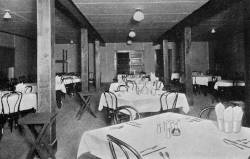
The Now Entrance makes Mammoth Cave accessible to the traveling public every day in the year. Situated on the Barren County Pike, seven miles from the I. & N. R. R. and the Dixie Highway at Cave City. With no dirt road to pass over, it is easily reached by auto or taxi regardless of weather conditions.
The New Entrance Hotel is situated five hundred feet north of the cave entrance on a high plateau (four hundred feet higher than Louisville) and overlooking the beautiful Doyel Valley in which there are several small lakes that offer opportunities for fishing and bathing.
The New Entrance Hotel is under the management of Mr. Wm. M. O’Neal. This assures cave visitors the same meals, service and comfort which has made the O’NEAL HOTELS famous.
The New Entrance has added two new routes in order to permit visitors to enjoy this underground wonderland without enduring the hardships of retracing. New discoveries, revealing more of the hidden beauty of the gnat cavern, also proved that the Onyx Avenue extended to within a i’vw yards of the surface and that an entrance could be made direct to the Onyx Chambers and on the same level as the cave avenues. This renders the cave accessible to the feeble, the invalid, the cripple and the aged. No steps to ascend or descend, no long walk up the hillside to auto, no corkscrew to crawl through, no strenuous exertion necessary. Onyx Chambers are as easily entered as the ordinary hotel, office building or church. No need to park the children or to chancre vour garments when you visit these marvelous Onyx Chambers.
NEW ENTRANCE HOTEL
Cave City, Ky.
RATES
Room — One person $1.50 and up per day.
Room — Two guests $1.25 per person per day.
Room — Three guests $1.00 per person per day.
MEALS
Breakfast $0.75
Lunch .75
Chicken dinner 1.00
Thus furnishing good rooms, good beds, and good meals at the rate of $3.50 to $4.00 per day if considered on the American plan.
For reservations write the New Entrance Hotel, Cave City, Ky.
RATES — CAVE TRIPS
Route No. 1, No. 2 or No. 4— $2.00; war tax, $0.20 or $2.20 for first trip, additional trips, $1.10 each. Trips start on the hour.
Route No. 3 or Loop Trip — This includes Routes No. 1 and No. 2 and the Loop, or three trips in one, $3.30. This trip starts at 9 A. M. and 3 P. M.
TRIP DELUXE — Includes four routes, two entrance and one of O’Neal’s famous lunches served in the cave, $5.00. Trip starts at 9 A. M. and 3 P. M. It requires 8 hours to make the DELUXE trip.
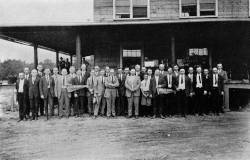
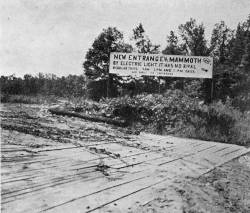
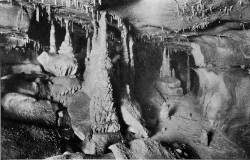
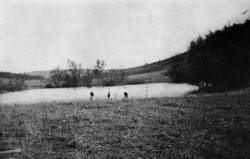
 Index
Index Topics
Topics Hierarchical
Hierarchical Countries
Countries Maps
Maps Search
Search